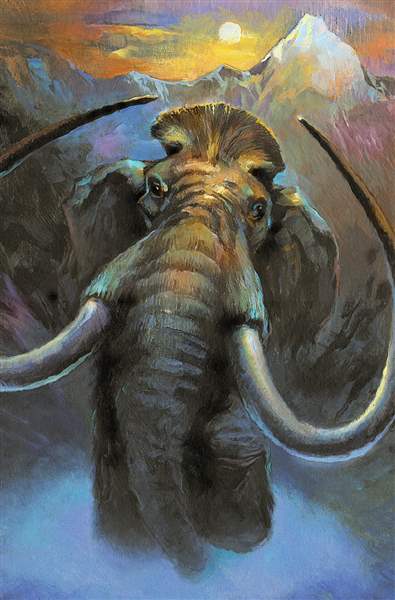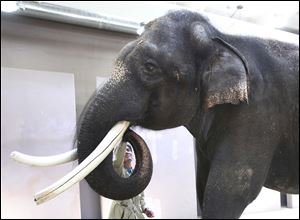
Scientists debate resurrecting long-extinct woolly mammoth
Lab working to put genes into Asian elephants
7/27/2014
Frozen, 10,000-year-old remains have allowed scientists to compare the DNA of woolly mammoths with that of modern elephants.
BLOCK NEWS ALLIANCE/DANIEL MARSULA

Frozen, 10,000-year-old remains have allowed scientists to compare the DNA of woolly mammoths with that of modern elephants.
One renowned Harvard scientist trumpets the idea of resurrecting the woolly mammoth — the ancient pachyderm that’s been extinct for 4,000 years.
Call it de-extinction.
And the public imagination seems open to a kinder, gentler version of Jurassic Park, with the canines of an angry carnivore replaced by the nearly backward curling tusks of a shaggy herbivore.
The question is whether it can happen. And why so much scientific interest in the genome of the woolly mammoth?
George Church, a professor of genetics at the Harvard medical school, oversees a laboratory that is working to insert woolly mammoth genes into Asian elephant cells. He wrote a 2013 article in Scientific American championing the benefits of genetically engineering Asian elephants with mammoth genes as a first step in resurrecting the mammoth.
It would allow the endangered Asian elephant to expand its range to the Russian and North American Arctic and subarctic areas farther south. In turn, it would help regenerate grasslands and improve biodiversity in tundras, while the roaming elephants would pack down the snow. This pachyderm pack-down would help insulate permafrost and reduce the melting that is causing the release of methane gas, a greenhouse gas that speeds up climate change.
Mr. Church said the debate — on the feasibility of constructing a mammoth or cold-tolerant elephant — is lively. But he cautions against claims that it is impossible and even expensive.
“I think it’s a good idea,” he said, explaining that it would involve genetically editing the Asian elephant genome to create a cold-resistant elephant. “With each step we become exponentially better at it. We’ve helped bring the costs down a million-fold, and they still are dropping quickly.”
As for those who disagree with him, he said, “I welcome their input.”
Permafrost clues
The idea of mammoth regenesis gained traction with the May, 2013, discovery of a fully intact but frozen baby mammoth carcass in a Siberian riverbank. The animal had died 10,000 years ago, near the end of the Ice Age. It still had liquid blood, but its cells were dead and degraded, dashing any hope that an intact mammoth genome could be obtained.

Inserting woolly mammoth DNA into the endangered Asian elephant would allow the animal to expand its range to the Russian and North American Arctic and subarctic areas farther south.
Still, the periodic discovery of mammoth bones, hair, and tissue allows geneticists to gather short sequences of DNA, which are being patched together by computer to generate mammoth genes. The process is helped by using the Asian elephant genome as a guide to where all the pieces fit. Webb Miller, a Penn State University geneticist, is studying the mammoth genome to identify differences between the mammoth and elephant.
The common ancestor of the woolly mammoth and Asian elephant existed about a million years ago. The mammoth developed the shaggy hair, subcutaneous layers of fat, and the genetically adapted ability to live with a colder core body temperature, all of which were necessary for survival in Siberia, although their range dipped as far south as current-day France, the National Geographic states.
The endangered Asian elephant weighs 3 tons, has a 22-month gestation period, and a daily diet of more than 300 pounds of roots, fruit, grasses, and bark. It is second only to the African elephant as the world’s largest land mammal. Mammoth and Asian elephant genomes are about as similar as human and chimpanzee genomes.
Chien Ho, a Carnegie Mellon University biologist, succeeded in replicating mammoth hemoglobin by changing four amino acids in elephant hemoglobin — the protein of the blood that transports oxygen. That replicated hemoglobin played a role in Mr. Church’s research. When temperatures are too cold, hemoglobin won’t release oxygen readily. But mammoth hemoglobin is not so sensitive to temperature changes, allowing it successfully to deliver oxygen bodywide in extremely cold.
The mammoth research has helped Mr. Ho, who holds a PhD, to understand and create oxygen-carrying fluids for use in resuscitating people who have experienced blood loss. But when it comes to regenerating the mammoth, he said, “I take a neutral position.”
“The big question is that it would be very expensive, and you would need a big yard to keep a woolly mammoth,” he said. “Technologically, it can be done. But you need to have good reasons to clone a woolly mammoth and other animals. I’m not objecting to it, but I’m not pushing hard for it to happen. My work would not help that.”
Pros and cons
Duquesne University professor Gerard Magill said the debate is less contentious among colleagues in his field of theology and bioethics, which addresses controversies arising from advances in science and medicine.
“The core of the [bioethical] debate is the safety issue,” he said. “The woolly mammoth lived a long time ago, but anything could be dangerous today. Diseases spread and are contagious and could destroy the human species. But that’s a very old debate. The probability of that is so small.
“Basic is the cost-benefit analysis, safety vs. knowledge,” he said. “Creating an animal would provide an enormous amount of information about biodiversity that would not be available by studying the genome. I think it is 80-20 in favor.”
One argument against re-creating the mammoth is that it diverts scientific attention from genetic research to benefit human health.
Two geneticists even expressed weariness in receiving the barrage of requests from reporters, researchers, and teachers seeking answers to a question seemingly borrowed from science fiction: Will the woolly mammoth someday, once again, walk on Earth?
“I have little interest in the idea,” said Mr. Miller, the Penn State geneticist whose 2008 study co-authored by Stephan Schuster, also of Penn State, involved sequencing a portion of the mammoth genome. “It’s technically very difficult. It would be technically much easier to clone or create a much younger, identical twin of, say, Winston Churchill, but a discussion of that idea is verboten.
“What’s much more interesting to me are questions about what’s already out there to help endangered species,” he said. “Should we focus, instead, on human-reproductive science?”
100% mammoth
Beth Shapiro, a professor in ecology and evolutionary biology at the University of California, Santa Cruz, works with the Church lab on woolly mammoth research. She said she doesn’t think it’s feasible to regenerate an original woolly mammoth, despite the title of her book, How to Clone a Woolly Mammoth, which is scheduled for release next spring.
Cloning an actual, 100 percent woolly mammoth simply is not possible, she said, because ancient cells are dead and the DNA is degraded.
“Bringing back a mammoth and putting it in a zoo is not a good reason for doing the research,” said the professor.
“Mammoth genes should be harnessed to help save the elephant,” she said. “In my mind, it is appropriate to make an elephant that can live in Siberia.”
She believes infusing an elephant with mammoth genes could occur within a decade.
But not everyone is happy that scientists would stop short of trying to re-create Jurassic Park.
“When I tell children that we cannot bring back woolly mammoths and certainly not dinosaurs, it breaks their hearts,” she said.
Block News Alliance consists of The Blade and Pittsburgh Post-Gazette. David Templeton is a staff writer for the Post-Gazette.
Contact him at: dtempleton@post-gazette.com or 412-263-1578.